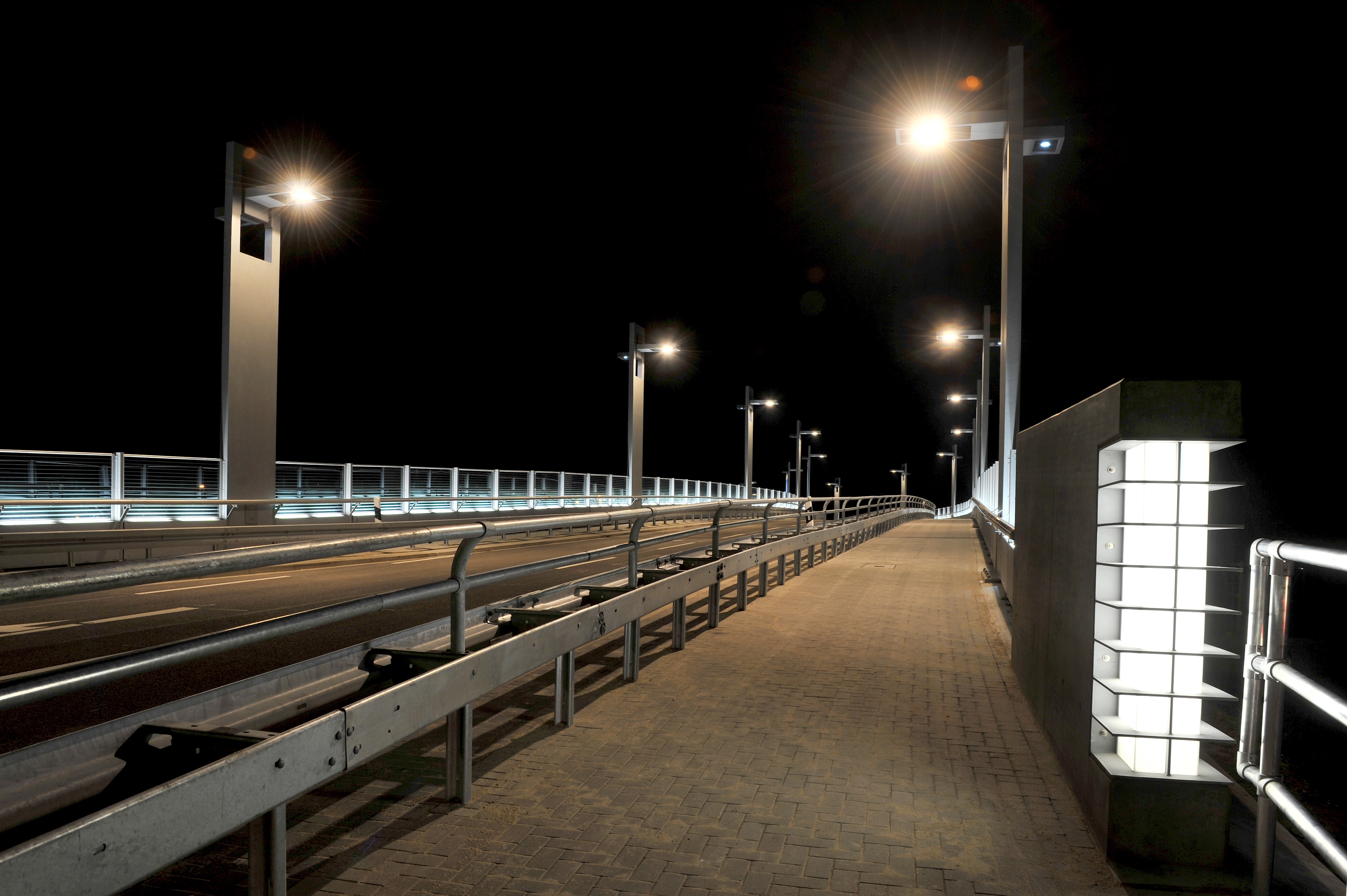Street lighting
Lighting of streets, roads and squares
The large number of these twilight switches also means that different weather conditions can be taken into account, as the intensity of daylight at dusk in Neindorf is often different to that in Brackstedt or Sülfeld. The majority of the distribution cabinets are also equipped with additional controls, which means that the output of the lighting systems in many streets is reduced at night when there is little traffic. Other lighting systems are only switched on when they are needed, for example during events, or when a road user approaches the luminaire.

-
The Wolfsburg street lighting
The lighting poles in the city area are between 3.5 and 12 m high. On the main roads and in the areas of major intersections and junctions, the lighting poles are the highest, here the wide traffic facilities require higher luminaires. The light is generated here without exception by technical luminaires, since these can distribute the light from the height better and are able to generate more light.
In the residential streets and along the sidewalks in green areas, lighting poles with a height of up to 5 m are used. This represents a good compromise between the quality of stay and the distance between the luminaires and still ensures the required lighting quality. A wide variety of luminaires are used, ranging from the restrained silhouette of a suitcase luminaire to long-established mushroom luminaires or even modern lantern shapes, to luminaires with special brackets or indirect distribution lighting systems.
The appearance of luminaires is constantly changing over the years. In the past often only in detail, but sometimes seriously through the use of new technologies. For example, with the light-emitting diode (LED), new designs are possible and often necessary to make the luminaire more durable. In the future, the appearance of the lights will change more clearly and certainly also become a bit more modern.
-
The technical progress
New technologies are of course taken into account in Wolfsburg, but not without scrutinizing and testing the innovations. Starting with individual test luminaires and moving on to smaller pilot systems, the innovations are tried out and initial experience gained. The changes in the way light is generated over the past decades can best be seen in the urban area. The high-pressure mercury discharge lamp (white light), which was installed until the early 1980s, is now obsolete. It was replaced in the course of the seventies by the sodium vapor high-pressure discharge lamp (yellow light) and represents until today one of the available possibilities to produce energy-efficient light.
Currently, the LED with its white light is spreading along the streets, paths and squares and is already the rule in Wolfsburg's residential streets for new buildings, in the future perhaps also along the higher roads - first tests are already being implemented. LEDs are also being used very frequently to replace old systems. Hardly noticeable from the outside, around 2,000 luminaires in Wolfsburg's streets are already lit with energy-efficient LEDs. Other energy-efficient lamp types ensure that the right light is produced for every Wolfsburg lighting system and that general safety is guaranteed.
-
Energy-saving potential
The control options for the lighting systems have also been further developed and are not perceptible to passers-by. Central "energy-saving modules" were tested and permanently operated in selected lighting systems to reduce power. For this purpose, installations were selected that required a lower lighting level due to changes in traffic frequencies. Modern LED luminaires are capable of generating different lighting levels over the night, so the light is "brighter" in the early evening hours than shortly before midnight and, since there is even less traffic between 1 a.m. and 5 a.m., for example, the lighting level is then reduced even further to be raised again with the onset of rush hour traffic - intelligent luminaires that are being tested in Wolfsburg in order to be able to save even more energy in the future if possible.
Travelling light
Elsewhere, further possibilities of modern LED lighting were explored. A small test installation provided initial findings on the subject of tracking light - the lighting system detects approaching road users and increases the "brightness" until the road user has left the area of the street light again. The result of this first pilot installation will be a complete residential area in the near future, in which the light automatically becomes brighter when there is movement in the road space.
Light as needed
Light as needed, this is currently being tested along a sidewalk and bike path. Here, users can switch on the light or use the path unlit according to their individual needs. After a preset time, the light goes out automatically; those who take a little more time for the route have the option of switching the light on again using the light switch or restarting the time from the beginning. This is a rather unique form of controlling a lighting system along a footpath and cycle path in Germany, but a successful way of using energy only when it is actually needed.
-
Malfunction messages
Since no technology lasts forever and the constant inspection of over 15,000 luminaires is difficult to afford, it happens that luminaires remain dark or show damage. Please give us a hint about malfunctions or damages. Please use one of the following options, but please remember to include a precise description of the location and the fault - thank you for your help.
-
Contact
Phone: 05361 28-1234
E-mail to Street Lighting Team
-
Contact
Contact
-
Contact
City of Wolfsburg
Division Road Construction and Project Coordination
Porschestrasse 49
38440 WolfsburgTelephone: 05361 28-1234
E-mail to the Road Construction Division